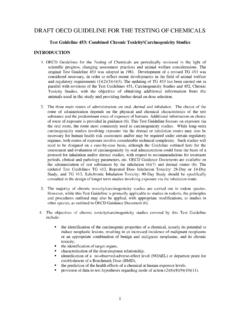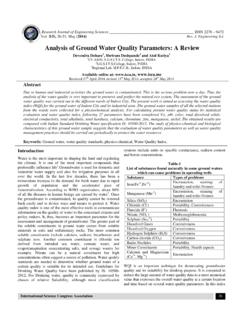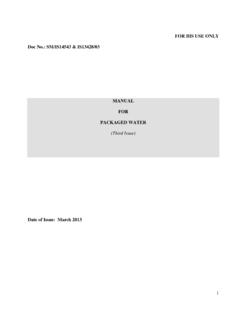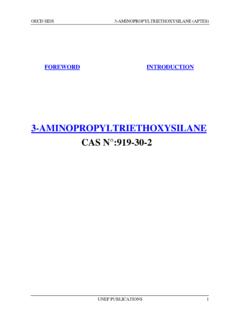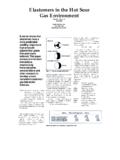Transcription of A STUDY OF PHYSICO -CHEMICAL QUALITY …
1 African Journal of Science and Research,2016,(5)4:50-54 ISSN: 2306-5877 Available Online: A STUDY OF PHYSICO -CHEMICAL QUALITY parameters OF drinking BOTTLED WATER IN MEKELLE CITY. Haddus Asheberom1, S. S. Mukharjee2 and Saini1* 1)Department of Chemistry, College of Natural and Computational Sciences,Mekelle 2)Department of Sport science, College of Natural and Computational Sciences,Mekelle University,Ethiopia.
2 Email: Received:21,July,2016 Accepted:26,Aug,2016 Abstract In context of growing health consciousness and persistent water shortages, most of the urban residents have switched to bottled water, a safe alternative with elevated QUALITY . The publically reported problems of public health tap water and the purity drive through advertisements have made it believable. The magnitude of either contamination or over/ under valued presence of minerals/ions in drinking water has its profound effects on consumer s health and creates related problems.
3 The PHYSICO -CHEMICAL analysis was carried on the bottled drinking water being supplied in Mekelle city. In present STUDY the sampled water bottles belongs to six different water supplying companies situated in different parts of Ethiopia. The results obtained from the STUDY have been compared with those labeled on the bottles, Ethiopian and WHO standards, mainly. The pH values of all the samples are close to each other and well within the permissible limits. The conductivity of the samples has been found in the range S/cm to S/cm. The calculated magnitude of TDS for each sample, though, higher than the company s claimed on the bottle-wrappers but still within the controlled limits of WHO.
4 The concentration of Ca, Mg, Na, K, Cl, SO4 ions were found very low than prescribed by Ethiopian and WHO standards, but to the higher side of reported values on the bottles. Keywords: Bottled water, Ethiopian & WHO standards, Mekelle, PHYSICO -CHEMICAL STUDY , QUALITY parameters . INTRODUCTION Available water resources are at the verge of attenuation and being aggravated by the population growth; both, in developing/developed nations though they are focusing the urgent need of effective water resource handling management for their sustainable development. The rate of the aggravating problem has a direct link with population growth, consequently, results the depletion of water resources.
5 Beside, increasing urbanization and climatic impacts; the domestic, industrial, livestock and Irrigation requirements have been increasing drastically day-by-day to feed-up the population. Adequate clean water is indispensable in both rural and urban areas to produce food for the population. It is just an aspect of the role played by water in meeting basic needs and contributing to development [Axel Bier, 2012]. Potable QUALITY water is the water free of chemical substances and disease producing micro-organisms that are perilous to health [Jain et.]
6 Al, 2010]. It contributes around 67% of human body weight, 75% of its brain, 83% of its blood, 22% of its bones, 75% of its muscles and 90% of its lungs (w/w) [Mitchell, 2016]. In real sense, pure water is a precious gift of nature to living organisms on the earth. drinking water QUALITY varies from place to place as it depends on conditions of the water source and the treatment it receives. The QUALITY problems in water often, have objectionable side effects [Mitchell, 2016]. These may be segregated in either of the following categories like colors, deposits, smells, spots, stains and tastes along with biological, inorganic and organic chemicals [SWRCB, 2015].
7 No doubt, the water QUALITY problems are very challenging, but fortunately being minimized by testing through osmometric, pH-metric, conductometric, complexometric, spectro-photometric methods, like on and may overcome by using different techniques- like chlorination, ozonization, uv-treatment etc. Water supply coverage in Ethiopia is one among the lowest even from most of the countries in sub-Sahara, according to reports indicated in 2007, national water supply coverage was ( rural and urban) [Khatri and Vairavamoorthy, 2007]. Almost there are a few studies conducted and published like this all but only one in the Ethiopian Medical Journals [Yenus et.]
8 Al, 2015] and another in International Journal of Science and Research [Biadglegne, 2009]. The first STUDY conducted at three sites in Amhara region reported that of the commercially available bottled drink water was unfit. Most recently, according to Dawn a newspaper of Pakistan, more than one hundred brands of the bottled water were found unsafe for drinking [Pak Newspaper- DAWN, 2016]. But the survey conducted at Addis Ababa showed the importance of drinking bottled water, according WHO standards, for wellness of people at work place, at home, functions and in traveling [Matiwos Ensermu, 2012].
9 With growing level of literacy public in Ethiopia have understood the significance of QUALITY drinking water, thus the demand of bottled drinking water has been increasing. Because, on dispensing bottled water, one becomes a smarter consumer, saves money, lives healthier, and join a movement for global sustainability. There is a growing concern towards the physical and chemical QUALITY parameters of this product besides the bacteriological ones. The Institute of Environmental Assessment and Water Research of the Spanish National Research Council (CSIC) revealed the presence of a few contaminants from plastic packaging or bottle lids in bottled water albeit in quantities much lower than limits found harmful for health [Albert , 2014 and Zoran Stevanovi , 2016].
10 NRDC recently completed a four year STUDY of bottled water, which included testing more than 1000 bottles of 103 brands of bottled water. The NRDC found that at least one sample of about one-third of the tested water contained significant contamination (where significant contamination means that it violated standards or guidelines). The contaminants that they found included arsenic, trihalo-methanes (including chloroform), excessive heterotrophic-plate-count (HPC) bacteria and elevated (but below standards) levels of nitrates [Joshi et. al, 2009; NRDC, 2016] In the present communication, we concern about the domestic use of good QUALITY water for various house hold purposes, especially for drinking .
